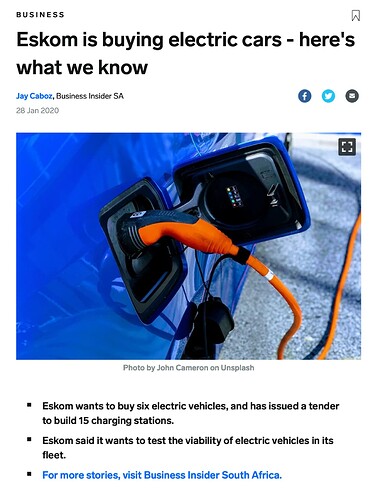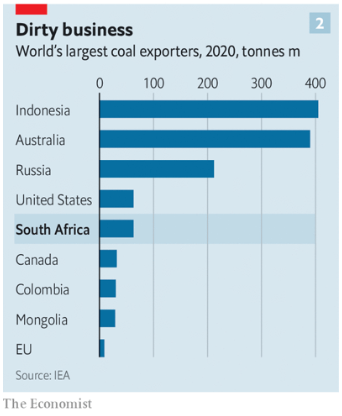A part of the article below: Engineering news 2021/10/29
Volkswagen and Toyota?
The vehicle brands topping the sales lists in South Africa like clockwork are Germany’s Volkswagen and Japan’s Toyota.
How do these more affordable brands plan to tackle electromobility in South Africa going forward?
“We are currently investigating various EV options for the Volkswagen brand in South Africa. As a brand, we have not finalised our decision yet,” says Volkswagen South AfricaPassenger Cars head Steffen Knapp.
The company does, however, have six e-Golfs on the road in South Africa as part of its Electric Mobility Pilot Project.
The vehicles –not for sale – are being tested by motoring and lifestyle media, selected dealers, as well as Volkswagen employees, in an effort to gain consumer insights into the varying experiences of driving and living with a BEV in South Africa.
Globally, Volkswagen is looking at how to make electromobility more affordable through its ID range, with the concept ID.LIFE small car having been unveiled earlier this year, for example.
Toyota South Africa (Toyota SA), similar to BMW, was a first mover in the country in terms of electromobility, with the introduction of the Prius hybrid on the local market in 2005.
At the time, it was the first new-energy vehicle (NEV) available in South Africa.
Today, Toyota’s premium brand, Lexus, has become the pioneering brand for hybrid technology in the country.
Lexus currently has an estimated 30% share in the local NEV market.
“This year, we saw Toyota SA playing a big role towards the introduction of NEVs with the launch of the Corolla sedan and RAV4 hybrids,” says the company.
“In November, Toyota will also be launching its first locally produced hybrid, the Corolla Cross, which will be available as a petrol-only variant.”
Toyota SA says it is looking to transition to a NEV mix of between 15% and 20% of local sales in the next five years, and up to between 30% and 40% over the next ten years.
“Due to their price, availability and self-charging capabilities (in other words, they are not dependent on charging infrastructure), [MHEVs] will form the core of our roll-out.”
Toyota SA adds, however, that it plans to add PHEV and BEV models to its model mix “where available and suitable”.
“We hope to have three to four PHEVs available in our local line-up over the next two years, with these likely to be midsized SUVs in the Toyota and Lexus portfolios.”
No Immediate Plans
The majority of vehicle brands in South Africa have no immediate programmes to bring a BEV or PHEV to the local market in 2022 and 2023.
Suzuki, one of the top-five vehicle sellers in the local market, says it has no plans to introduce such a vehicle in the near future.
The same is true for Mazda, Renault, Ford and Hyundai.
Globally, Mazda, Ford and Hyundai have, however, announced major investments in BEVs and/or hydrogen vehicles, with Ford, for example, hoping that about half of the cars it sells by 2030 will be zero-emission.
Still Evaluating . . .
Kia South Africa says it is continuously evaluating the suitability of introducing BEVs, PHEVs and MHEVs on the South African market in line with its new brand strategy – movement that inspires – and a related focus on advanced technologies.
“However, from a pricing perspective, it’s important that these vehicles are priced in line with market and customer expectations. To make that a reality, there is a need now, more than ever, for a level of subsidy by government.
“That said, we plan to bring in new technology into the country for extensive evaluation to ensure that Kia will be at the forefront when the mainstream automotive market in South Africa adopts the wide-scale introduction of EV tech.”
Mahindra says it is a pioneer of EV technology in India, with a range of zero- emission vehicles on offer, ranging from two-wheelers, three-wheelers, passenger vehicles and SUVs to, ultimately, the electric Battista hypercar from its affiliate, Pininfarina.
“Among the many vehicles available to Mahindra is the all-new XUV300 Electric, which will be launched in India in the near future,” says Mahindra South Africa CEO Rajesh Gupta.
“Mahindra South Africa is studying the market potential for EVs in South Africa. It is also participating in industry groups through its affiliation with Naamsa | The AutomotiveBusiness Council to lobby policymakers to create the necessary policies that will allow for the cost-effective introduction of these vehicles.”
It is not entirely clear what Nissan, the one-time leader in BEVs in South Africa, is planning for the future.
“As this technology becomes more accessible, and more and more charging stations around the country are produced, we’re confident the uptake of EVs will increase,” says the local arm of the Japanese company.
“We intend to launch some new, first-to-market technologyin 2022 within our product stable.”
Yet another Japanese car maker, Honda, will, by 2040, have no other choice but to sell BEVs and fuel-cell vehicles in South Africa, as the company CEO has announced that Honda will exclusively sell battery-electric and hydrogen fuel-cell vehicles by 2040. ![]()



